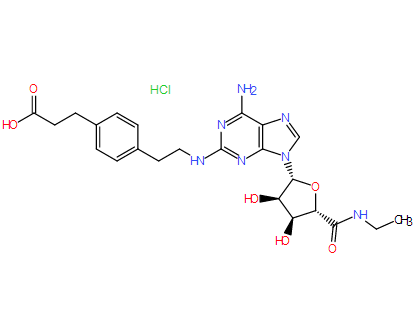| Cas No.: | 124431-80-7 |
| Chemical Name: | 4-[2-[[6-Amino-9-(N-ethyl-β-D-ribofuranuronamidosyl)-9H-purin-2-yl]amino]ethyl]benzenepropanoic acid hydrochloride |
| Synonyms: | CGS21680,CGS-21680,CGS 21680 |
| SMILES: | O=C(O)CCC1=CC=C(CCNC2=NC(N)=C3N=CN([C@@H]4O[C@H](C(NCC)=O)[C@@H](O)[C@H]4O)C3=N2)C=C1.[H]Cl |
| Formula: | C23H29N7O6.HCl |
| M.Wt: | 535.99 |
| Purity: | >98% |
| Sotrage: | 2 years -20°C Powder, 2 weeks 4°C in DMSO, 6 months -80°C in DMSO |
| Description: | CGS 21680 Hydrochloride is a selective adenosine A2A receptor agonist with a Ki of 27 nM. |
| In Vivo: | CGS21680 (1 mg/kg/i.p.) intervention promotes the development of EAN. CGS21680 exacerbates experimental autoimmune neuritis in Lewis rats induced with bovine peripheral myelin. The exacerbation is accompanied with reduced CD4+ Foxp3+ T cells, increased CD4+ CXCR5+ T cells, B cells, dendritic cells and antigen-specific autoantibodies, which is possibly due to the inhibition of IL-2 induced by CGS21680[2]. CGS21680 (0.1 mg/kg, i.p.) transiently increases heart frequency but does not modify blood pressure of rat, and does not modify either heart frequency or blood pressure at 0.01 mg/kg. Following transient MCAo, CGS21680 at both doses protects from neurological deficit from the first day up to 7 days thereafter. At this time, it has reduced microgliosis, astrogliosis and improved myelin organization in the striatum and cytoarchitecture of the ischemic cortex and striatum. Two days after transient MCAo, CGS21680 has reduced the number of infiltrated granulocytes into the ischemic tissue[3]. |
| In Vitro: | CGS21680 significantly upregulates CD39 and CD73 expression. CGS21680 accelerates the adenosine triphosphate (ATP) hydrolysis and adenosine generation[1]. CGS21680 (10 nM) alone shows only small survival activity, but the activity is significantly enhanced by the addition of a phosphodiesterase inhibitor, IBMX. The survival activity of CGS21680 on cultured motoneurons is exerted by mixed effects of the adenylate cyclase-cAMP-PKA pathway and the transactivation of neurotrophin receptors[4]. |






















